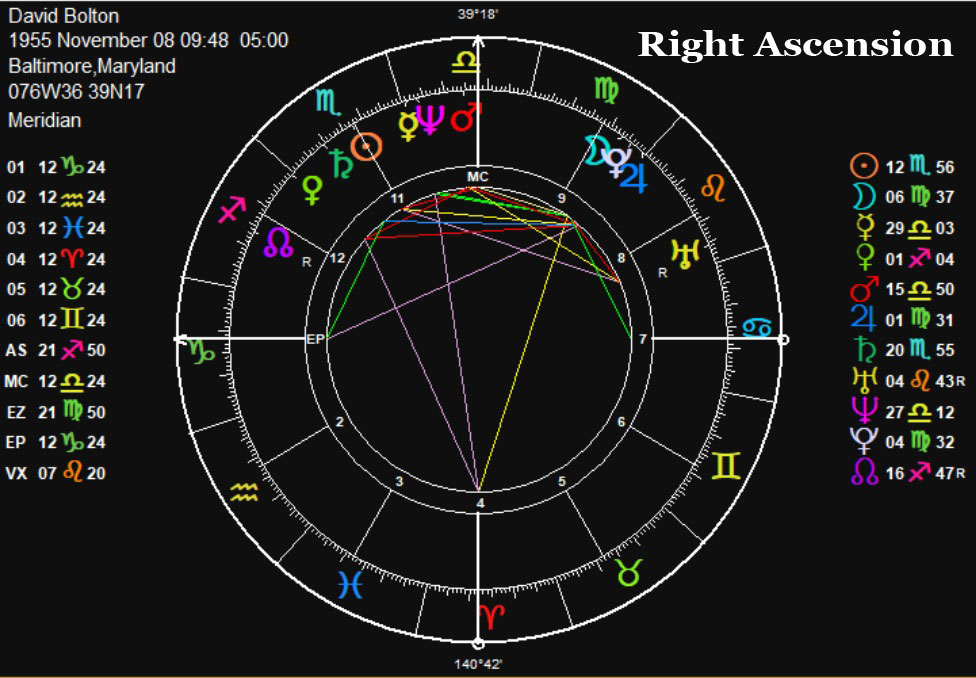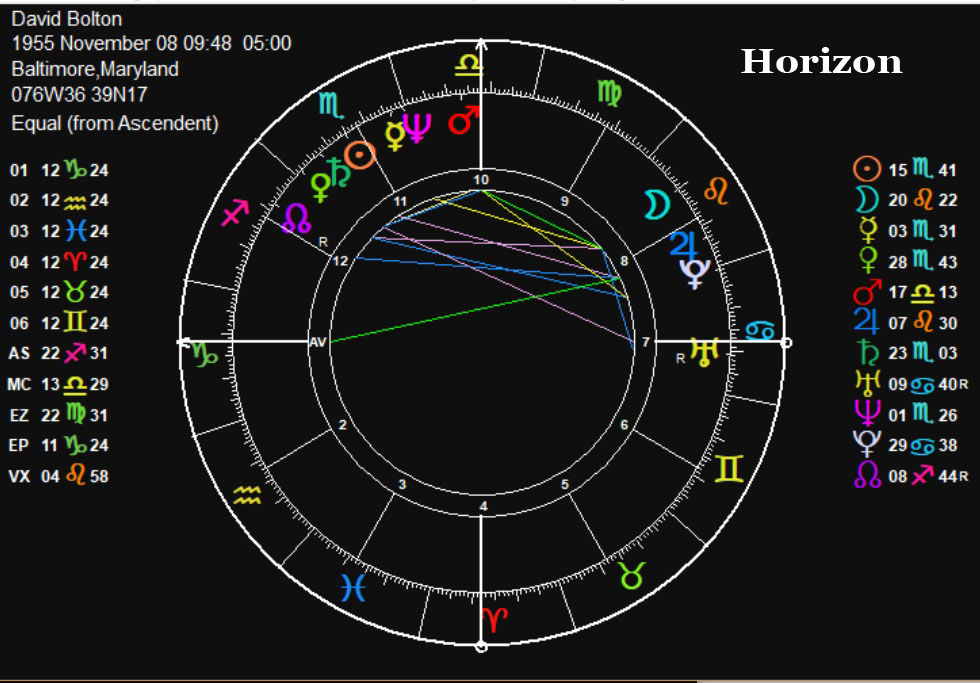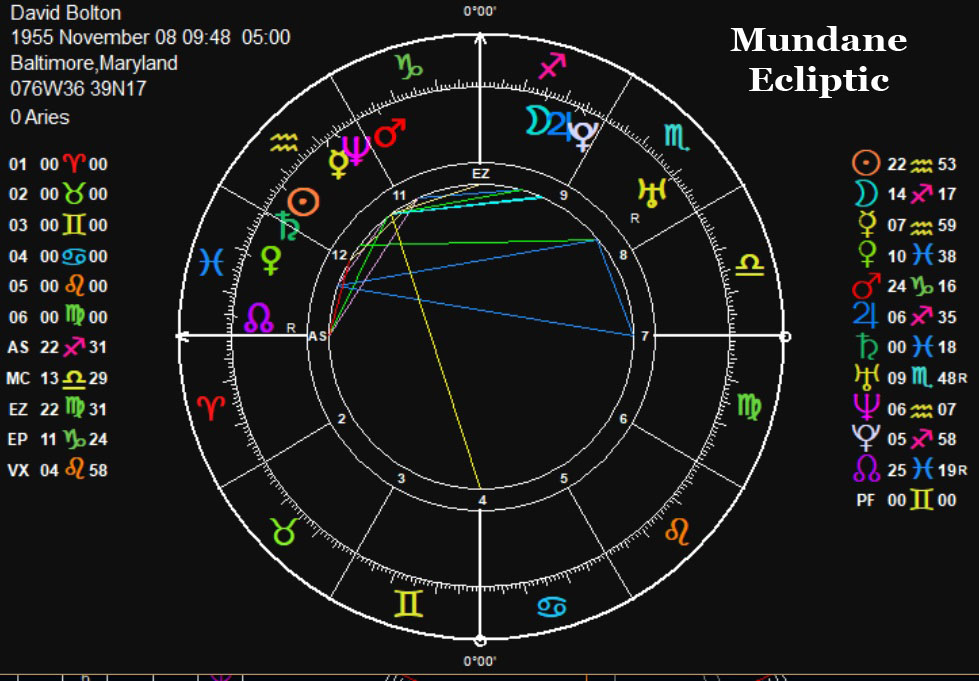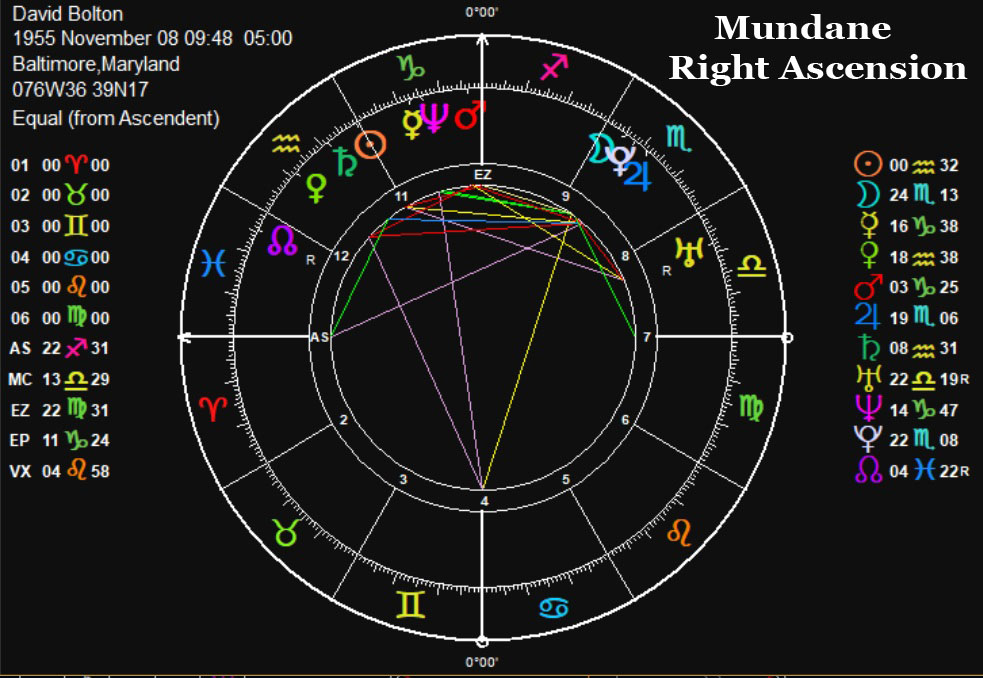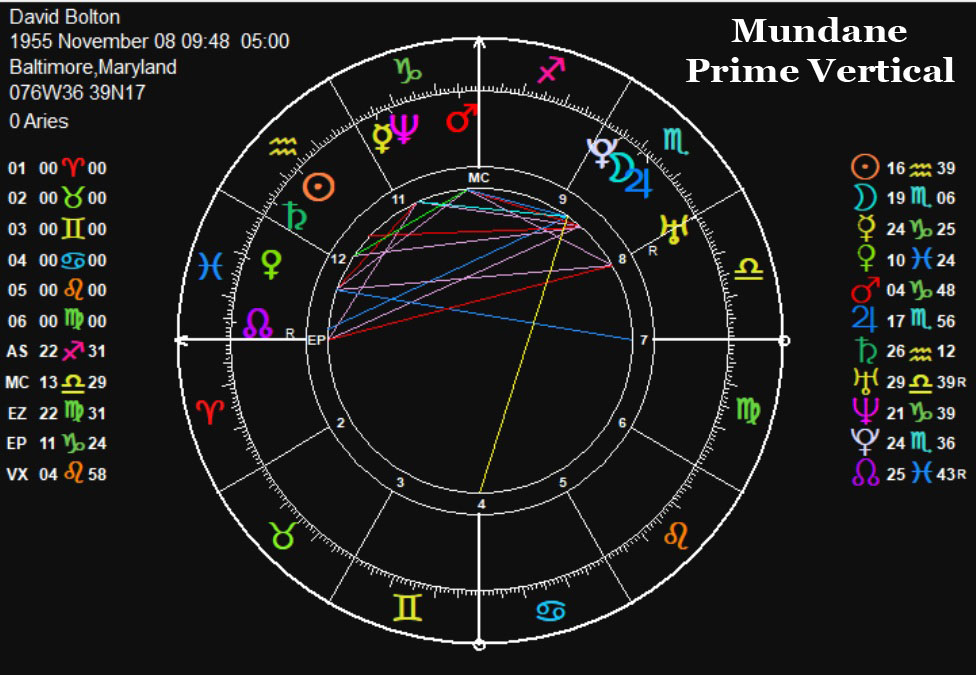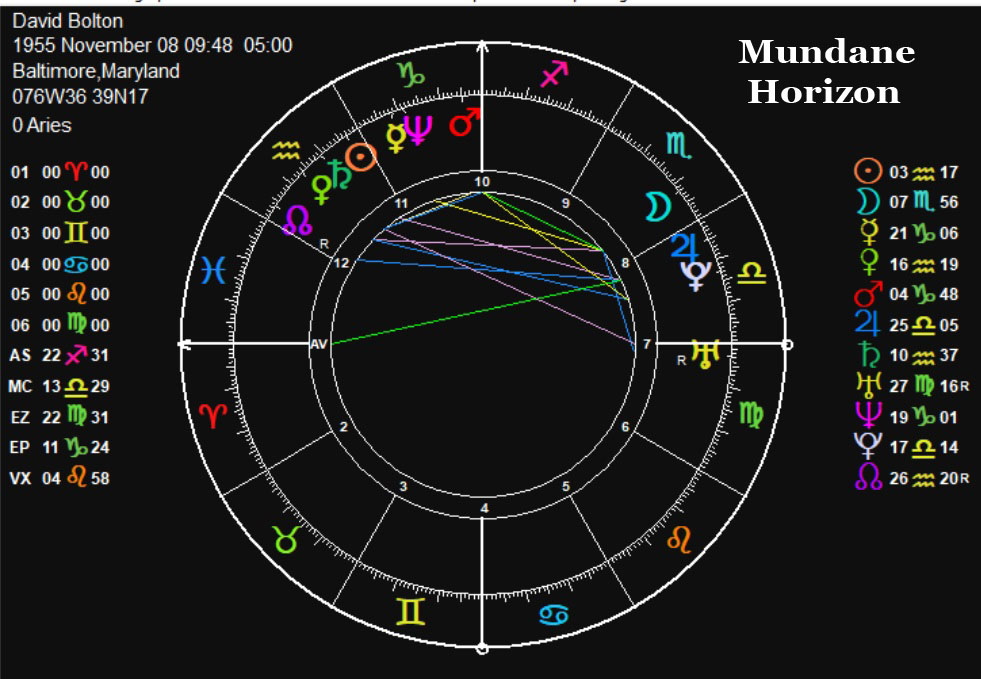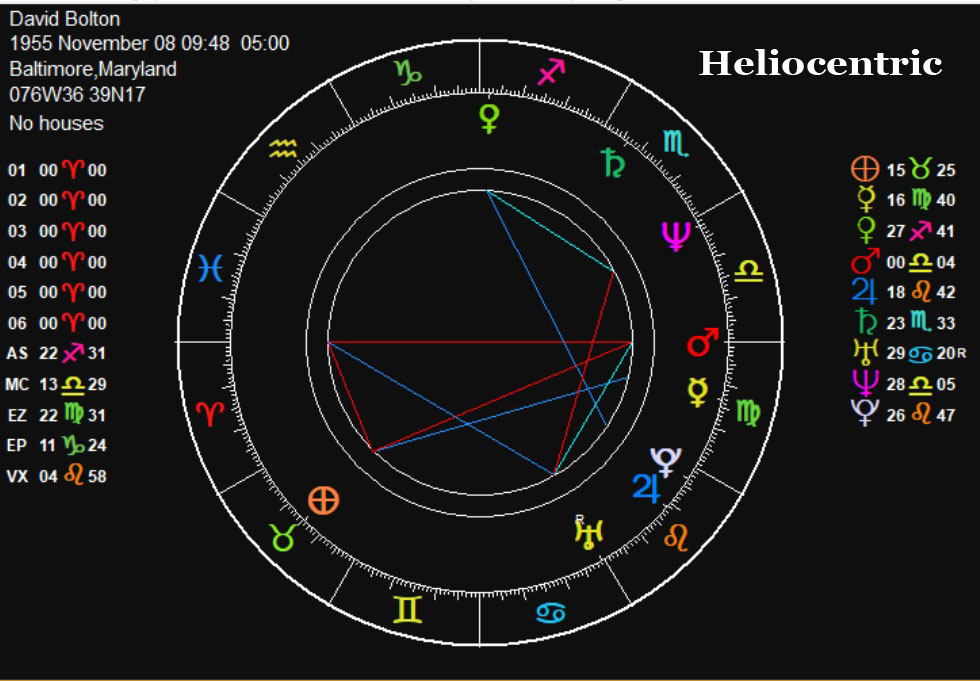
(click covers for more information) |
Many astrologers don't realize that the planetary positions in a chart can be plotted in more than just one coordinate system. True, the Ecliptic is the first choice, since the Sun is always on the Ecliptic, and the Moon and planets also move along it, more or less. I say "more or less" because except for the Sun, the planets are almost never exactly on the Ecliptic. As a matter of fact, Pluto in a chart can easily by over 15° away from the Ecliptic! In order to view our "normal" natal charts, it is therefore necessary to project all of the planets onto the Ecliptic - that is, to "flatten out" the picture by treating them as though they were exactly on that plane, even though they in reality are not. The following picture illustrates this point: |
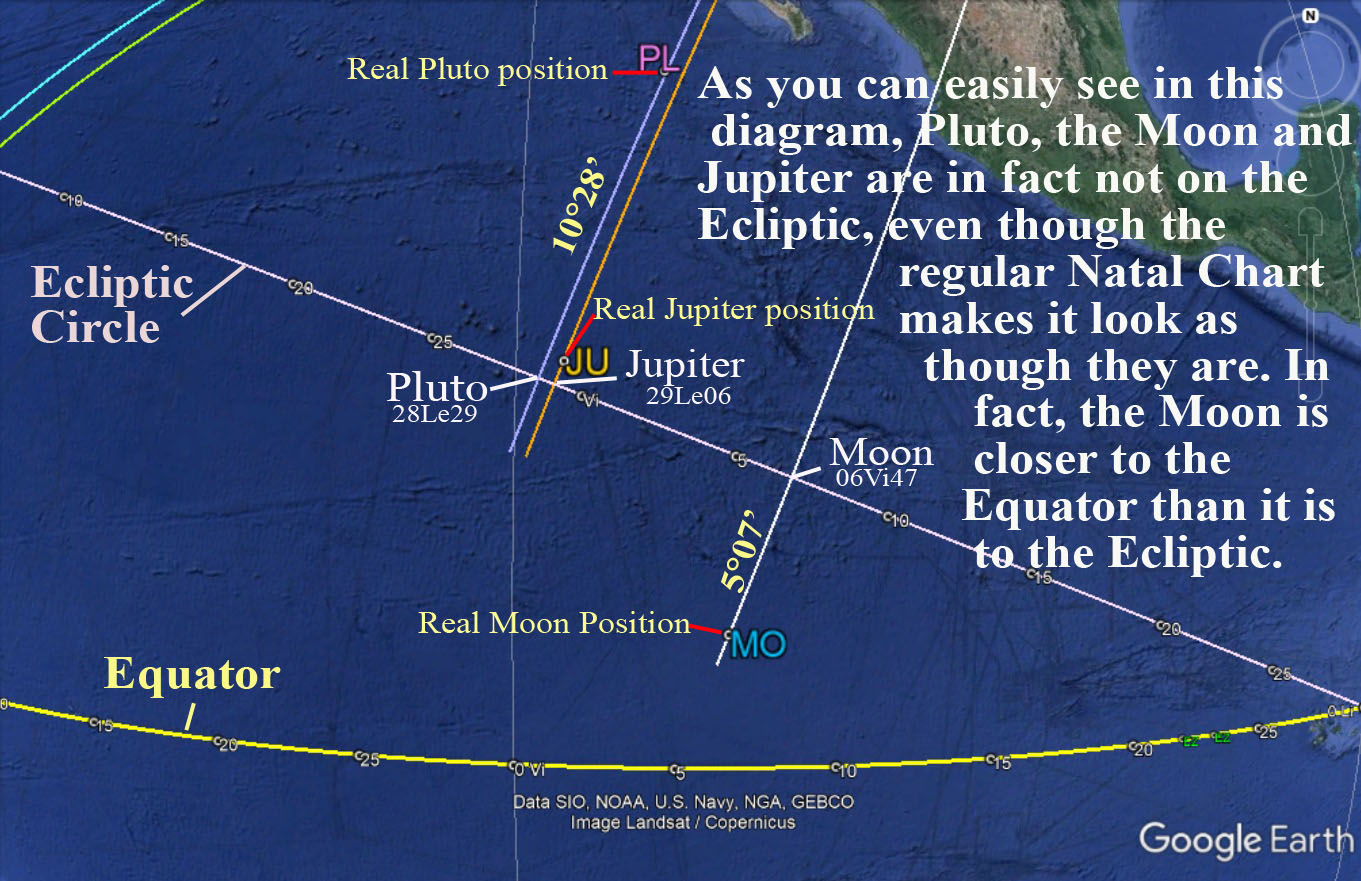
If you looked at my chart, you would see that I have the Moon in Virgo, at 06Vi47; Pluto is at 28Le27, and Juputer at 29Le06. In the above picture, those "ecliptic" positions are indicated in white. However, it is plain to see that in reality, none of those three planets was on the Ecliptic (the pink line) when I was born. Jupiter was close to it; it was less than 1° from the Ecliptic. The Moon, however, was over 5° below the Eclitpic; Pluto was more than 10° above it. Why, then does a normal astrological chart represent these three planets as being "on the Ecliptic"? Well, astrologers "flatten" the 3-dimensionality of the chart so that all the factors appear on a common plane (in this case, the Ecliptic plane). They then proceed to measure aspects on this plane, note the transits to the ecliptic positions, etc. Note: the lines running through the real planetary positions in the diagram (those points marked simply "PL", "JU", and "MO") all converge at the Pole of the Ecliptic, a point 90° from any and all points on the Ecliptic Circle. (Just as the North Pole is 90° from all points on the Equator). I am not saying that the planetary ecliptic positions "don't work", since in over 40 years as an astrologer, I have seen thousands of times that they are valid. However, might it not also be valid to use other projections? That is, instead of projecting the planets only onto the Ecliptic, in order to cast the "regular" Natal Chart, couldn't we project them onto the Equator, for example, and thus create a supplementary chart, one in Right Ascension? In order to do so, you would draw lines through the planets, but those lines would not have the Pole of the Ecliptic as their starting point, but rather, the Pole of the Equator, i.e., the North (or South) Pole of the Earth. Here's a second diagram, showing these same planets projected not onto the Ecliptic, but onto the Equator (Note: whenever you project onto a plane, the projection line must cross that plane at a 90° angle): |
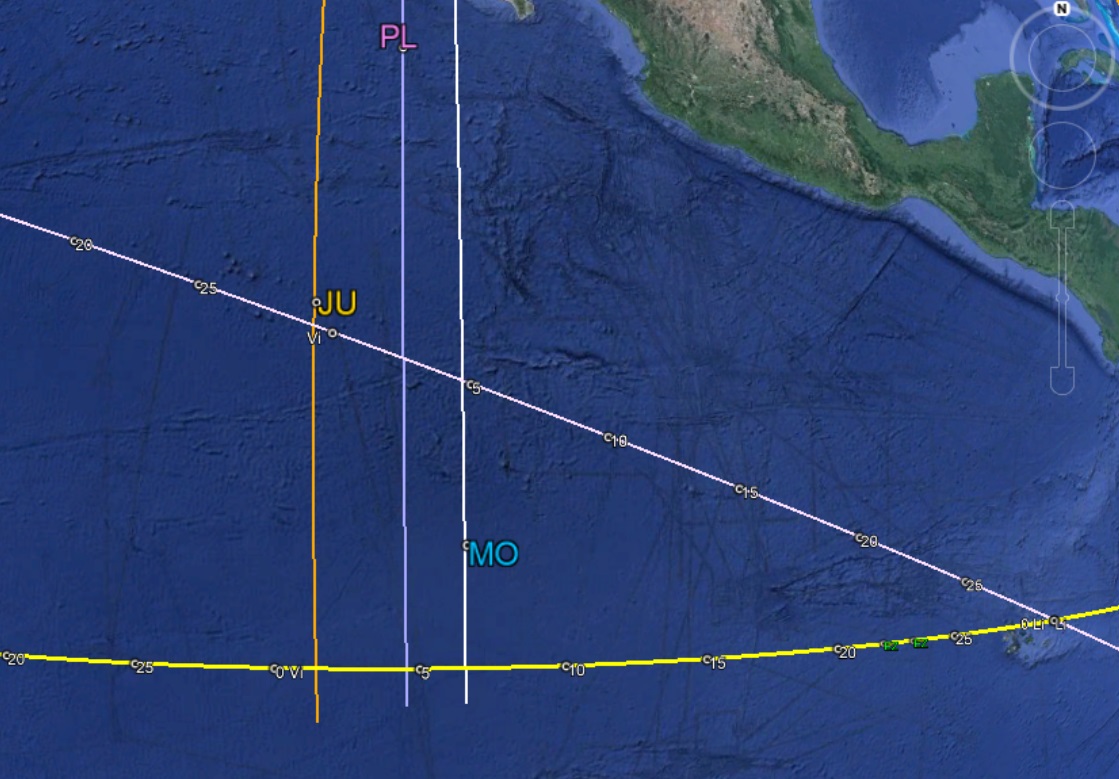
Now, there's no need to worry about having to do all this work just to see your chart in Right Ascension, or some other coordinate system. Omnicycles naturally does all these calculations automatically: once you cast your "normal" chart, you can change it to another system at the click of a button. Here, I merely thought I'd give you some insights into what these other charts are based on, astronomically speaking. For the last few years, I have routinely examined charts not only in "Ecliptic" format (what we as astrolgers normally use), but also in several other coordinate systems: Right Ascension, Prime Vertical, and Horizon. Experience has shown me that these other systems can definitely add to chart and transit interpretation. Moreover, in the case of transits in Right Ascension (abbreviated "R.A.", or simply "RA"), many times an event will occur when a transit is exact in RA, but not on the Ecliptic! This is why Omnicycles offers you a choice of coordinate systems: so that you, too, can explore the possibilities that these systems offer for deepening your understanding of a chart. There follows a list of the coordinate systems available in Omnicycles. Note that all of these reference planes are what we call "Great Circles", i.e., circles that divide the earthly sphere into two equal parts. 1) Ecliptic: This is the standard coordinate system used in astrology. The planets, if not already on the Ecliptic, are projected onto it from the Pole of the Ecliptic. 2) Right Ascension (RA): In this system, the planets are projected onto the Equator, from the North (or South) Pole of the Earth. 3) Prime Vertical: Here, the planets are projected onto the Prime Vertical (PV) from its pole. The PV is a circle that passes through the place of birth, going east-west. It intersects the Equator at the "East Point" and "West Point". If you were born exactly on the Equator, your PV would be equivalent to the Equator; since you probably weren't, then your PV, passing through your birth place, will intersect the Equator at the two points mentioned above. 4) Horizon: This is the basis for the oft-discussed "Local Space Chart". The planets are projected onto the Horizon of the place of birth. 5) Zenith Chart: This is a very special chart available in Omnicycles: it shows just where the planets really were (that is, not "projected positions") with reference to the place of birth, which in this chart is always the point in the center. 6) Helio: The Heliocentric positions of the birth planets. To get an idea of the differences between these charts, hover your mouse over the images below. All are my own Natal Chart, but each one in a different coordinate system: |
In addition, Omnicycles gives "Mundane" positions for charts in Ecliptic, RA, PV and Horizon format (we've even thrown in a "Mundane Meridian Chart" for experimental purposes). What is a "Mundane Chart"? It is one that stresses the daily movement of the planets around the Earth. By way of example, we'll take the Sun. At sunrise, the Sun is of course on the eastern horizon; at noon, it has reached its culmination; hours later, it sets in the west, and at true midnight, it is at "anti-culmination", i.e., it is on the other side of the Earth. You probably know that on the Ecliptic, the Sun takes a full year to go, for instance, from 0° Aries all around the zodiac to finally reach that position once again. Thus, the Sun moves at the speed of about 1° per day along the Ecliptic. In the houses, however, the situation is quite different. Here, the Sun makes one full revolution aorund the Earth in the course of a single day. (OK, more precisely: "apparent" revolution, since naturally, it is the Earth that is moving, not the Sun!) Through the houses, therefore, the Sun moves 1° every 4 minutes of time. Mundane charts are excellent for discovering those moments of a day that are somehow special, as they are influenced by the planets that are rising, setting, culminating or reaching their nadir. In addition, the positions in a Mundane Chart can be compared to your own Mundane Birth Chart, so that you can see how a specfic moment of the day may be influencing you. Omnicycles offers Mundane Charts in five different coordinate systems: Ecliptic, RA, PV, Horizon and Meridian. Because the basis of a Mundane Chart is not the zodiac, but rather, the houses, we must have some way of naming the chart positions. It is general practice to use the signs of the zodiac, though in fact, a planet e.g. in Taurus in a Mundane Chart has nothing to do with that sign: it is simply a convenient way of saying that that planet is in the second house. For you see, in a Mundane Chart, the first house will always be represented by Aries; House 2, by Taurus; House 3, Gemini, and so on. I myself do not find this "sign-house" analogy to be totally logical for this type of chart; we have nonetheless adopted the convention simply because it is more familiar to most astrologers. Once you get a bit of experience using various coordinates, your astrological horizons will be noticeably broadened! Should this topic seem difficult to grasp, don't worry: download Omnicycles, do your chart in "normal" Ecliptic format, then switch to other systems; do the same for a number of charts, and use the "current chart" feature to check out the transits, also in other coordinate systems. Just make sure you compare charts only if they are of the same type: RA to RA, Ecliptic to Ecliptic, etc. (Calculating aspects between charts of different systems will not give valid results.) Soon you will see the tremendous possibilites of viewing the chart from various perspectives. For those who wish to gain a much more profound understanding of the technical side of this, and other issues, I highly recommend you check out my book "Technical Astrology made Simplified", available at Amazon.com (see the books at the end of this page). So now, why not download Omnicycles for Windows and install it? After all, it's free. Have fun exploring the many possibilites that Omnicycles offers you! |




